[Esp]Ejercitar las piernas, estira y fortalece los músculos isquiotibiales./Eng]Exercising the legs, stretches and strengthens the hamstring muscles.
En el cuerpo contamos, con un grupo muscular, denominado los músculos isquiotibiales, los cuales están ubicados en la parte trasera de la pierna, abajo del glúteo, ellos se extienden a lo largo de la parte posterior del muslo desde la cadera, hasta la región debajo de la rodilla, cumpliendo diversas funciones esenciales, entre ellas; de ayudar a extender la cadera, para llevar el muslo hacia atrás, así como también, en la rotación interna hacia dentro y externa hacia fuera de dicha parte del cuerpo. Los músculos isquiotibiales, además tienen un papel destacado, al momento de flexionar o doblar la rodilla, asímismo al rotarla interna y externamente, en ese orden de ideas, cuando se desarrollan ejercicios para trabajar las piernas, se estiran y fortalecen los músculos isquiotibiales, contribuyéndose también, a evitar lesiones en la espalda baja, las rodillas, los glúteos y las pantorrillas. En tal sentido, los músculos descritos, son muy importantes, por cuanto permiten tener unas piernas muy bien trabajadas y definidas, beneficios que también se pueden lograr con el desarrollo de las posturas Hindolasana o la cuna del bebé y su variante, las cuales se realizan, sentados con el torso derecho y los brazos alzados, mientras dejamos una pierna flexionada en la esterilla, procediendo a levantar y cruzar la otra pierna, llevándola hacia el pecho, colocando un pie en la corva o curvatura de un codo y la rodilla en la otra, para abrazar dicha pierna con los brazos y entrecruzar los dedos de las manos, cumpliendo luego su variante, al tomar la citada pierna con las manos, alejándola del pecho, las asanas señaladas, además de contribuir con el estiramiento y fortalecimiento de los músculos isquiotibiales, permiten el proceso de relajación de las tensiones en la espalda baja y las caderas, asimismo, masajear los órganos internos del abdomen, tales como; el estómago, el intestino delgado e intestino grueso, el hígado, el bazo, la vesícula biliar, el páncreas, el útero, las trompas de falopio, los ovarios, los riñones, los uréteres, la vejiga y una gran cantidad de vasos sanguíneos. La referida asana y su variante, también ayudan a calmar la mente y alivian la ansiedad. Motivado a la importancia de las referidas posturas, permítanme solicitar su compañía, para desarrollarlas, con el propósito de seguir sanándonos física y mentalmente. Éxitos.
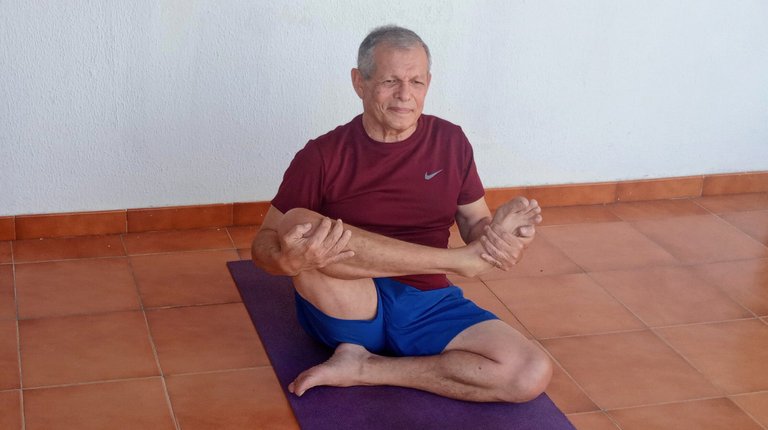
In the body we have a muscle group, called the hamstring muscles, which are located in the back of the leg, below the buttock, they extend along the back of the thigh from the hip, to the region below the knee, fulfilling various essential functions, including; to help extend the hip, to bring the thigh backwards, as well as, in the internal inward and external outward rotation of that part of the body. The hamstring muscles also play a prominent role when flexing or bending the knee, as well as rotating it internally and externally, in that order of ideas, when exercises are developed to work the legs, the hamstring muscles are stretched and strengthened, contributing also, to avoid injuries to the lower back, knees, buttocks and calves. In this sense, the muscles described are very important, since they allow to have very well worked and defined legs, benefits that can also be achieved with the development of the Hindolasana postures or the baby's cradle and its variant, which are performed, sitting with the torso straight and arms raised, while leaving one leg flexed on the mat, proceeding to raise and cross the other leg, bringing it towards the chest, placing one foot on the crook or curve of one elbow and the knee on the other, to embrace said leg with the arms and interlock the fingers of the hands, then fulfilling its variant, by taking the aforementioned leg with the hands, moving it away from the chest, the indicated asanas, in addition to contributing to the stretching and strengthening of the hamstring muscles, allow the relaxation process of tensions in the lower back and hips, also massage the internal organs of the abdomen, such as; the stomach, the small and large intestines, the liver, the spleen, the gallbladder, the pancreas, the uterus, the fallopian tubes, the ovaries, the kidneys, the ureters, the bladder, and a large number of blood vessels. The aforementioned asana and its variant also help calm the mind and relieve anxiety. Motivated by the importance of the aforementioned postures, allow me to request your company, to develop them, with the purpose of continuing to heal ourselves physically and mentally. Successes.
Proceso de Meditación
Es muy necesario meditar consecuentemente, antes de iniciar a calentar el cuerpo, con la finalidad de relajarnos y calmar la mente, para ello aplicaremos la postura que se muestra y expresa a continuación; estando sentados con la espalda derecha, las piernas flexionadas delante del cuerpo y las plantas de los pies hacia los glúteos, levantamos los brazos, juntando las palmas de las manos frente al rostro, para reflexionar e interanalizar los siguientes escritos: 1)"Si te ofreces ayudar al prójimo, no esperes nada a cambio, hazlo con humildad y sinceridad. Quien hace todo de corazón, siempre es recompensado" . 2)"Vigila tu mente, por cuanto mientras más te quejas, más te debilitas, en cambio cuando más agrdadeces, tu fortalecimiento es mayor". 3)"Sin saberlo, puedes estar viviendo los mejores años de tu vida, disfrútalos y agradece siempre". Éxitos.
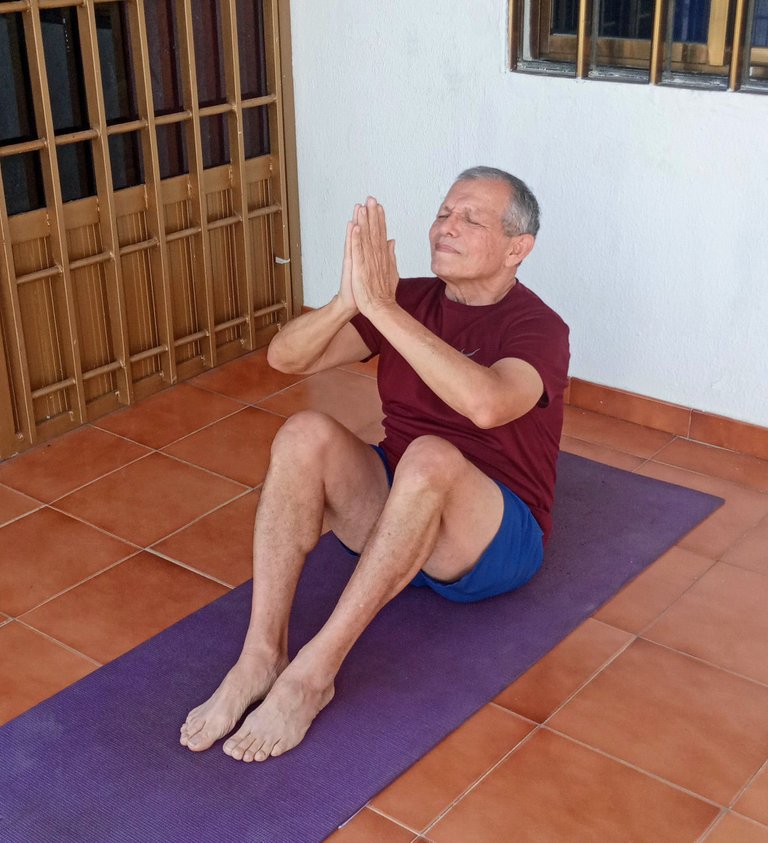
Meditation Process
It is very necessary to meditate consistently, before starting to warm up the body, in order to relax and calm the mind, for this we will apply the posture shown and expressed below; While sitting with our back straight, our legs bent in front of our body and the soles of our feet towards our buttocks, we raise our arms, joining the palms of our hands in front of our face, to reflect on and analyze the following writings: 1) "If you you offer to help your neighbor, do not expect anything in return, do it with humility and sincerity. Whoever does everything from the heart is always rewarded" . 2) "Watch your mind, because the more you complain, the more you weaken, instead when you are more grateful, your strength is greater". 3) "Without knowing it, you may be living the best years of your life, enjoy them and always be thankful". Successes.
Ejercicios para el calentamiento corporal
Con el propósito de lograr un buen rendimiento, evitar lesiones, flexibilizar los músculos y articulaciones, procederemos a calentar el cuerpo, lo cual es bien importante, antes del desarrollo de las posturas de yoga. El citado proceso lo cumpliremos, con la finalidad de equilibrarnos e iniciar a fortalecer los músculos de la espalda, el abdomen, las extremidades superiores e inferiores y el core, dichos movimientos tendrán una duración de 12 minutos, descansando 10 segundos por cada dos minutos de ellos, conforme se indica a continuación:
Con el cuerpo arrodillado, manteniendo la espalda derecha, conjuntamente, con los brazos extendidos al frente, suavemente flexionamos el torso hacia la derecha, luego a la izquierda.
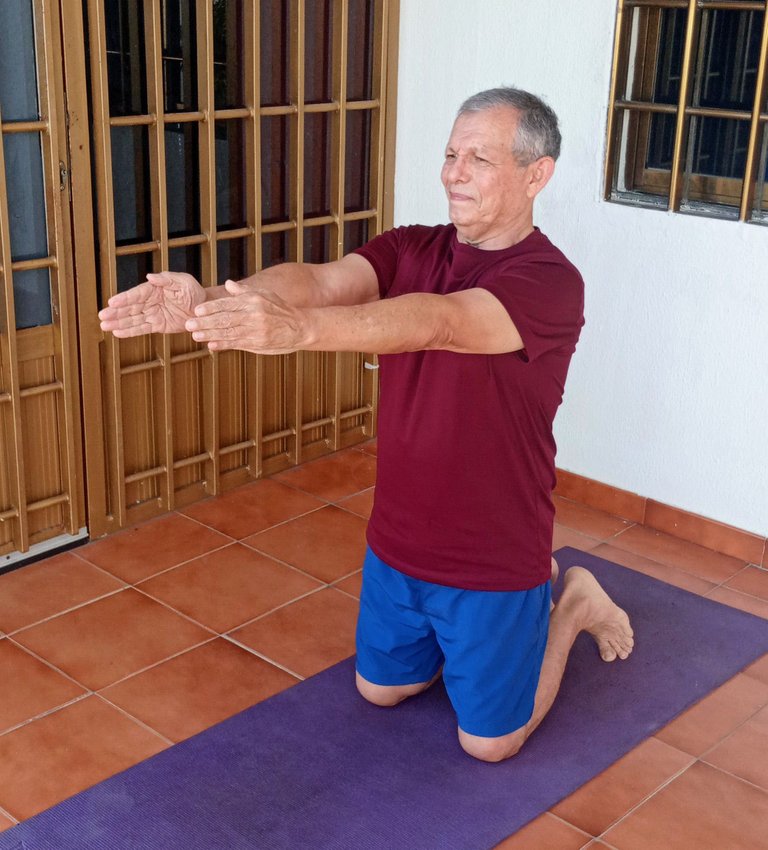
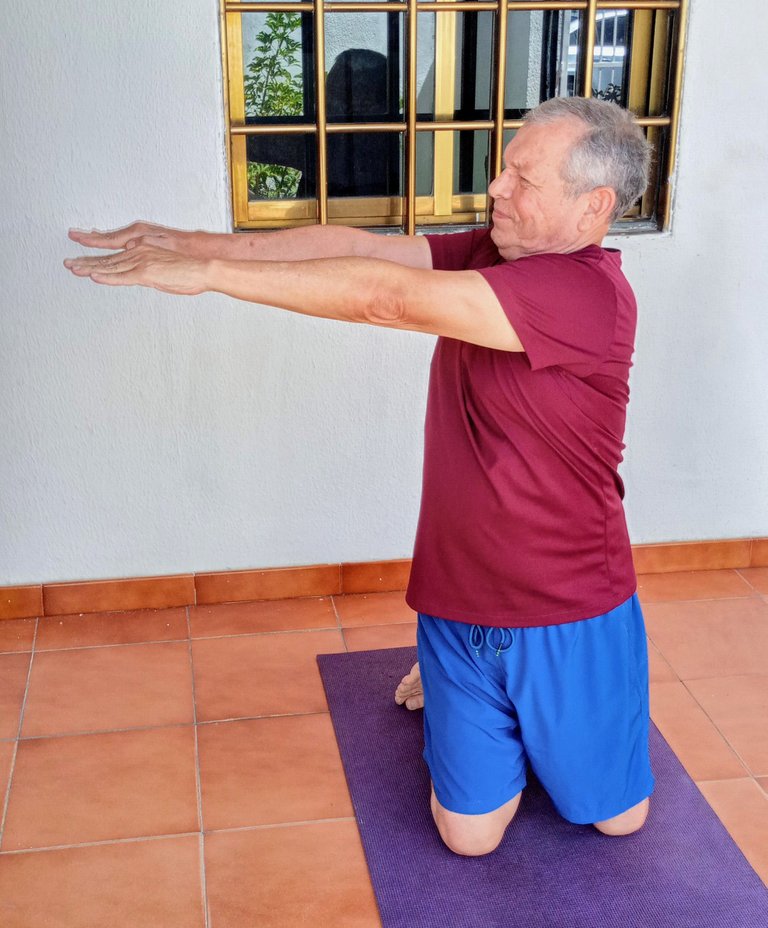

Exercises for body warm-up
In order to achieve good performance, avoid injuries, and make the muscles and joints more flexible, we will proceed to warm up the body, which is very important, before developing the yoga postures. We will comply with the aforementioned process, in order to balance ourselves and begin to strengthen the muscles of the back, abdomen, upper and lower extremities and the core, these movements will have a duration of 12 minutes, resting 10 seconds for every two minutes of them, as indicated below:
With the body kneeling, keeping the back straight, together, with the arms extended in front, we gently flex the torso to the right, then to the left.
Continuamos arrodillados, con los brazos extendidos, en esta ocasión flexionamos suavemente el torso hacia delante, direccionando las manos hacia abajo, hasta apoyarlas en la esterilla, seguidamente adelantamos la pierna derecha con la rodilla doblada, ubicando el pie entre las manos, apoyándolo en la esterilla, repitiendo el ejercicio, con la pierna izquierda flexionada, la cual adelantamos colocando el pie entre las manos y en dicha esterilla.
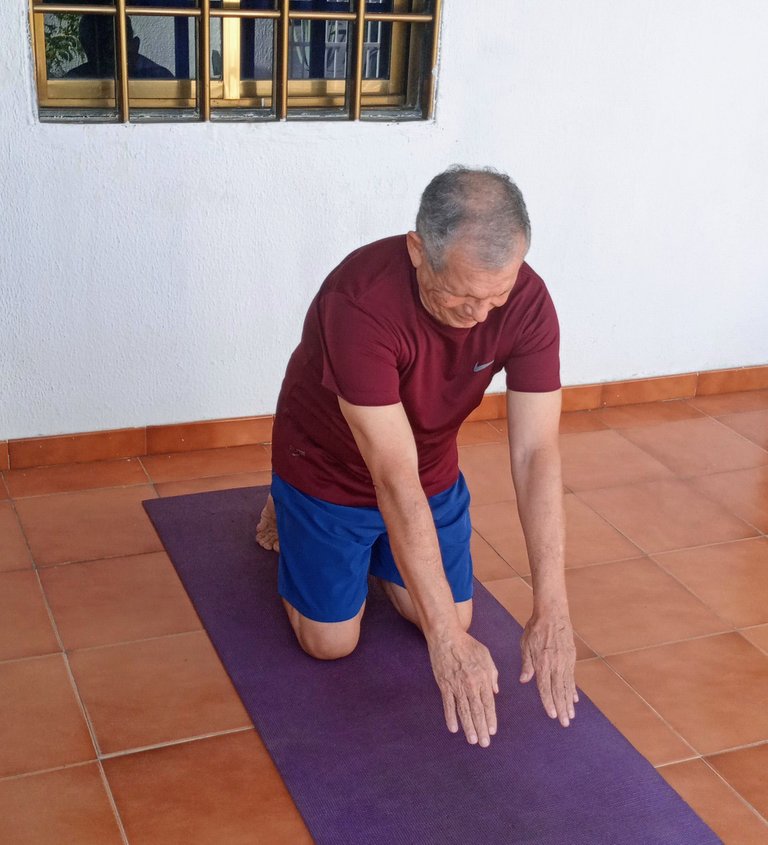
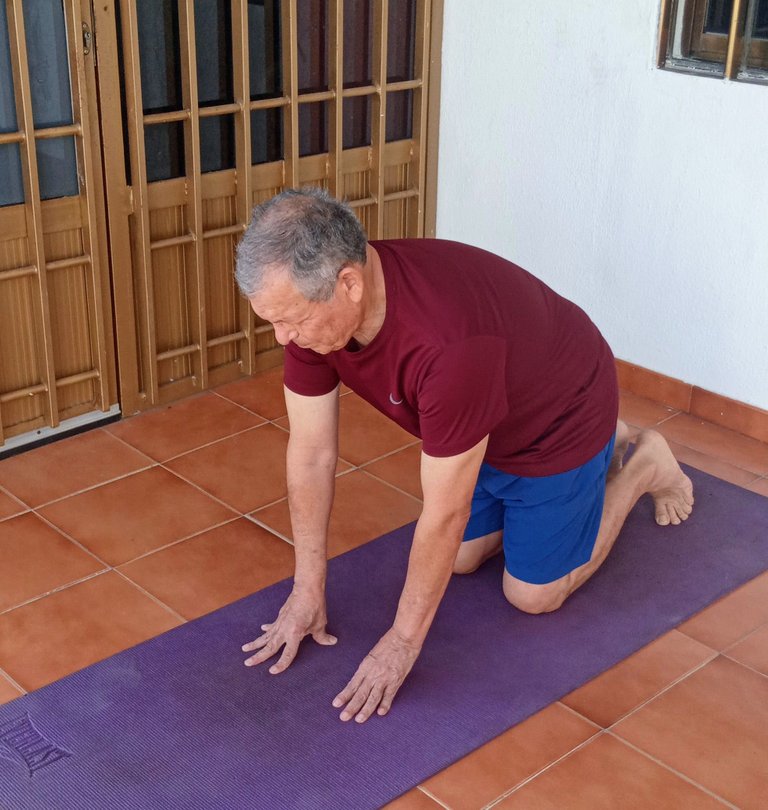
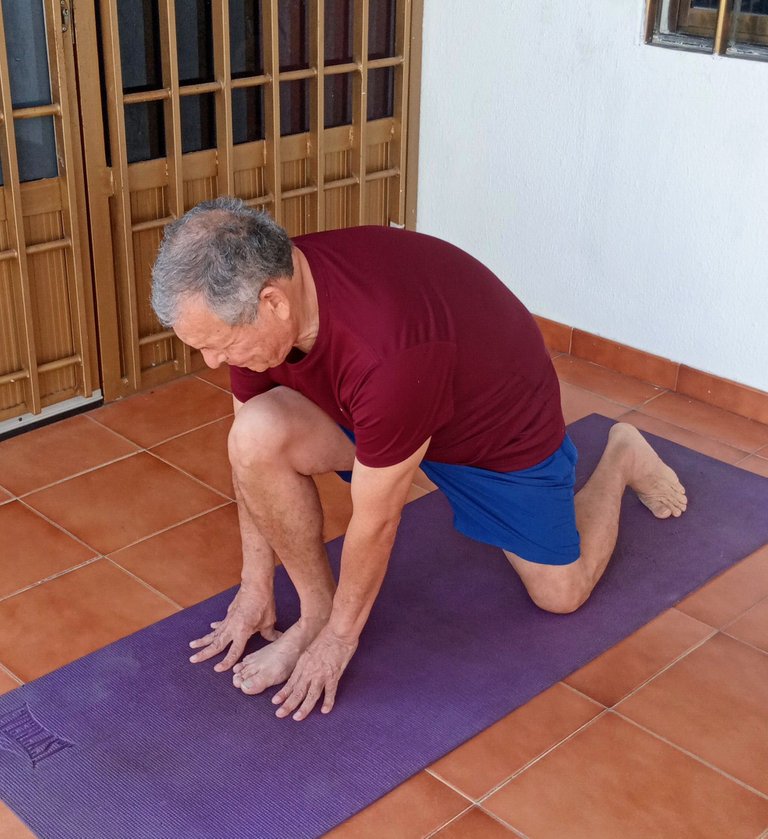
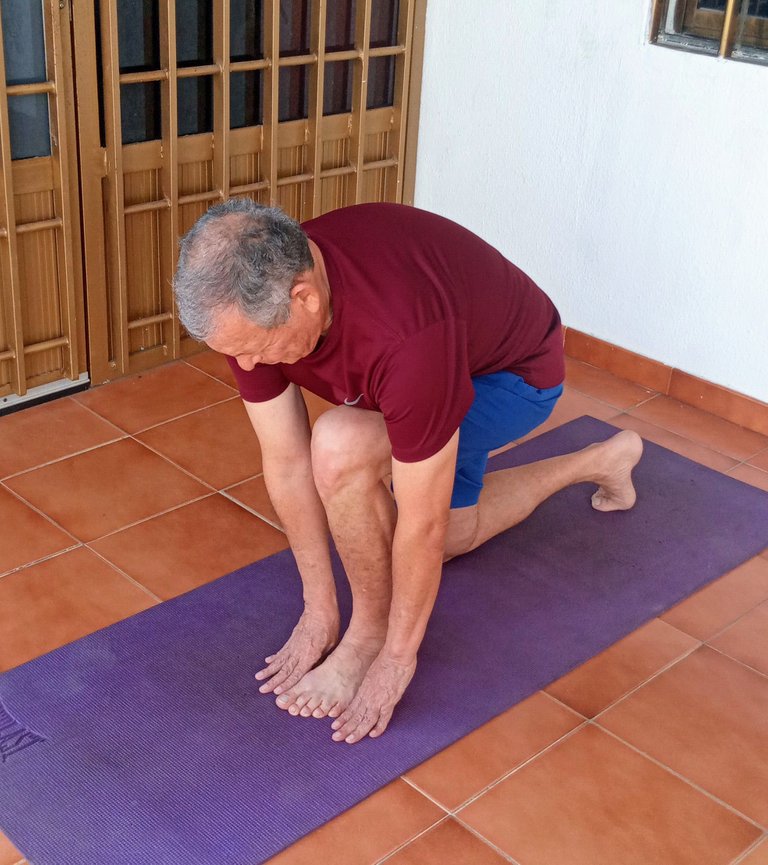
We continue kneeling, with our arms outstretched, this time we gently bend our torso forward, directing our hands downwards, until we rest them on the mat, then we advance our right leg with the knee bent, placing the foot between our hands, resting it on the mat, repeating the exercise, with the left leg flexed, which we advance by placing the foot between the hands and on said mat.
Ubicados en la posición inicial, es decir arrodillados con la espalda recta, los brazos extendidos al frente, adelantamos la pierna derecha flexionada, apoyando la mano del citado lado en la rodilla, mientras la mano izquierda la dejamos en la cintura, seguidamente repetimos el ejercicio, adelantando la pierna izquierda flexionada, apoyando la mano de dicho lado en la rodilla, dejando la mano derecha en la cintura. Todas las acciones, se deben desarrollar, en atención al tiempo indicado, con sus respectivos descansos. Éxitos.

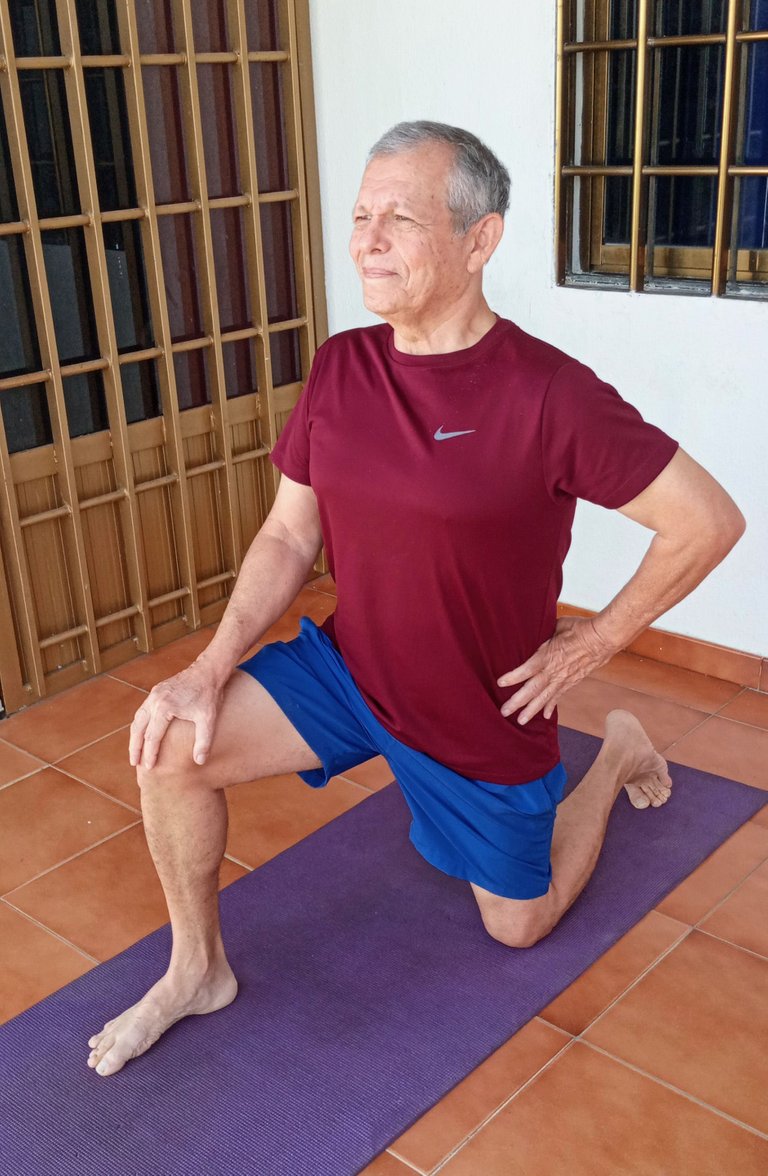
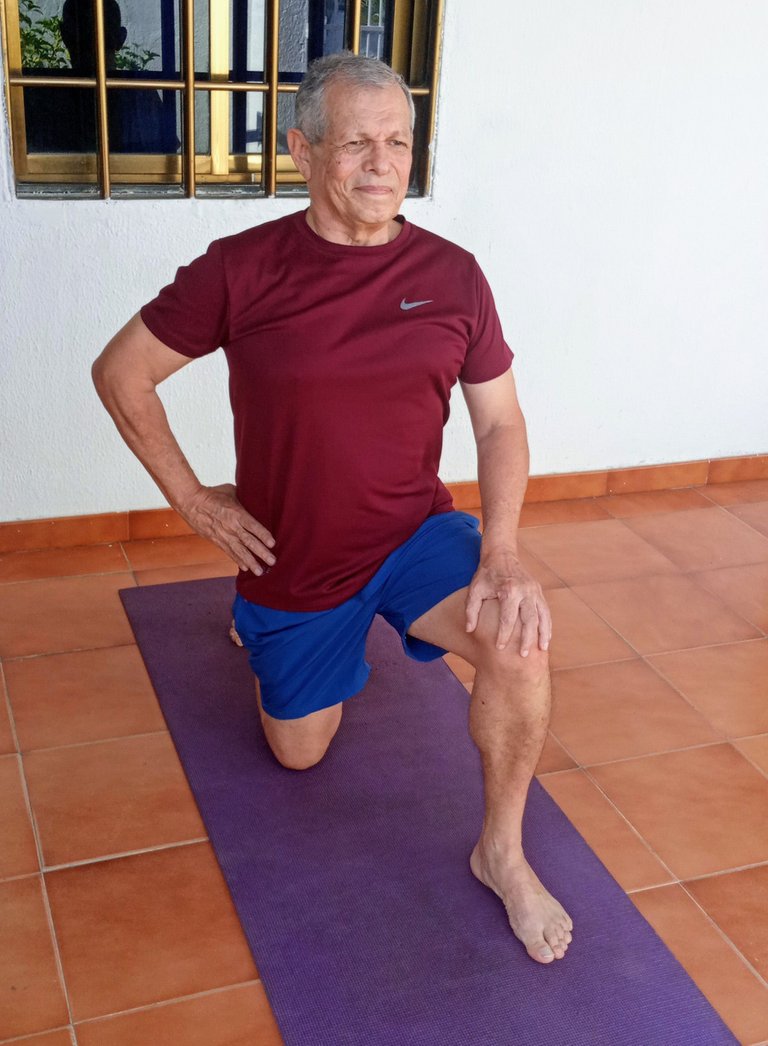
Located in the initial position, that is, kneeling with a straight back, arms extended in front, we advance the flexed right leg, supporting the hand of that side on the knee, while the left hand is left on the waist, then we repeat the exercise , advancing the bent left leg, resting the hand on that side on the knee, leaving the right hand on the waist. All actions must be developed, in attention to the indicated time, with their respective breaks. Successes.
Desarrollo de la postura Hindolasana o la cuna del bebé y su variante, las cuales se realizan, sentados con el torso derecho y los brazos alzados, mientras dejamos una pierna flexionada en la esterilla, procedemos a levantar y cruzar la otra pierna, llevándola hacia el pecho, colocando un pie en la corva o curvatura de un codo y la rodilla en la otra, abrazando la pierna con los brazos, entrecruzando los dedos de las manos, luego tomamos dicha pierna con las manos, alejándola del pecho
Iniciamos ubicados en Sukhasana o Siddhasana, denominada postura fácil, la cual se realiza, estando sentados con la espalda derecha, los brazos a los lados, entrecruzando las piernas delante del cuerpo, sin necesidad de colocar cada pie en el muslo de la pierna contraria, por eso se denomina fácil, por cuanto es menos complicada que en la asana la flor de loto o Padmasana, donde las piernas se entrecruzan, con cada pie apoyado en el muslo de La pierna contraria. La asana
Sukhasana o Siddhasana, es buena para la meditación, ayuda a flexibilizar las rodillas, es relajante, mejorando la circulación sanguínea y la postura. Equilibrados inspiramos, aguantamos y expulsamos aire. Éxitos.
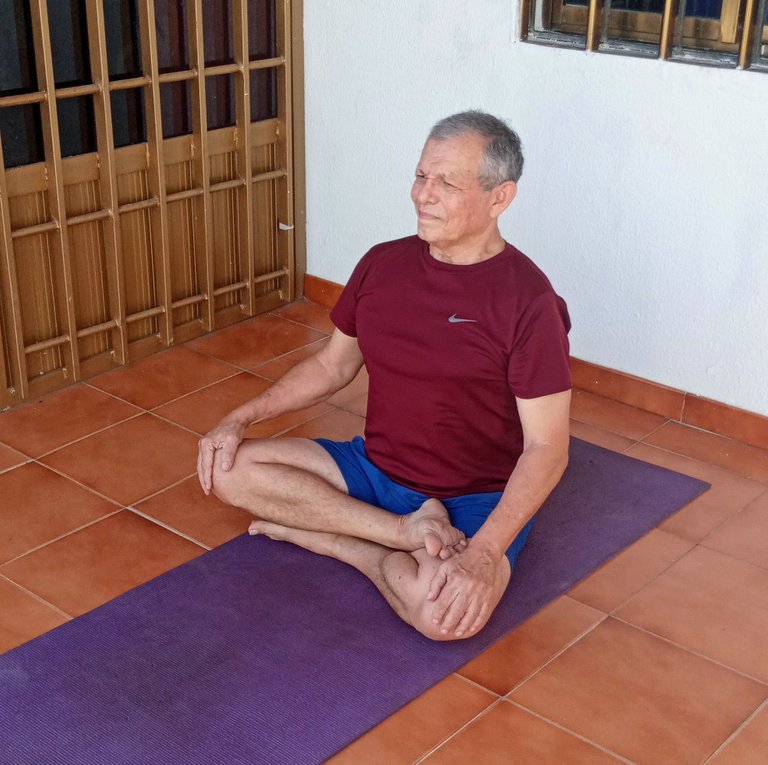
Development of the Hindolasana posture or the baby's cradle and its variant, which are performed, sitting with the torso straight and arms raised, while leaving one leg flexed on the mat, we proceed to raise and cross the other leg, carrying it towards the chest, placing one foot on the hamstring or bend of one elbow and the knee on the other, hugging the leg with the arms, interlocking the fingers of the hands, then we take said leg with the hands, moving it away from the chest
We begin in Sukhasana or Siddhasana, called easy posture, which is done while sitting with your back straight, arms at your sides, crossing your legs in front of your body, without the need to place each foot on the thigh of the opposite leg. That is why it is called easy, because it is less complicated than in the asana the lotus flower or Padmasana, where the legs intersect, with each foot resting on the thigh of the opposite leg. the pose Sukhasana or Siddhasana, is good for meditation, helps make the knees more flexible, is relaxing, improves blood circulation and posture. Balanced we inspire, hold and expel air. Successes.
Manteniendo la espalda derecha, dejando la pierna izquierda flexionada, apoyada en la esterilla, suavemente procedemos a levantar y flexionar la pierna derecha, colocando el pie de dicho lado en la corva del codo derecho y la rodilla en la otra corva del codo izquierdo, dejando los antebrazos direccionados hacia arriba, mientras llevamos la pierna hacia el pecho, seguidamente conformamos Hindolasana o la cuna del bebé, logrando abrazar la pierna derecha, es decir la que está levantada, al entrelazar los dedos de las manos, por tal motivo se llamados la cuna del bebé, incluso podemos hasta masajear el abdomen y generar fuerza corporal, girando el torso con suavidad, como si fuese una cuna, en cuanto a la postura durando 30 segundos, para ejercitarnos o en movimiento, tres minutos, equilibrados y en resistencia corporal, inspirando, aguantando y expulsando aire. Éxitos.
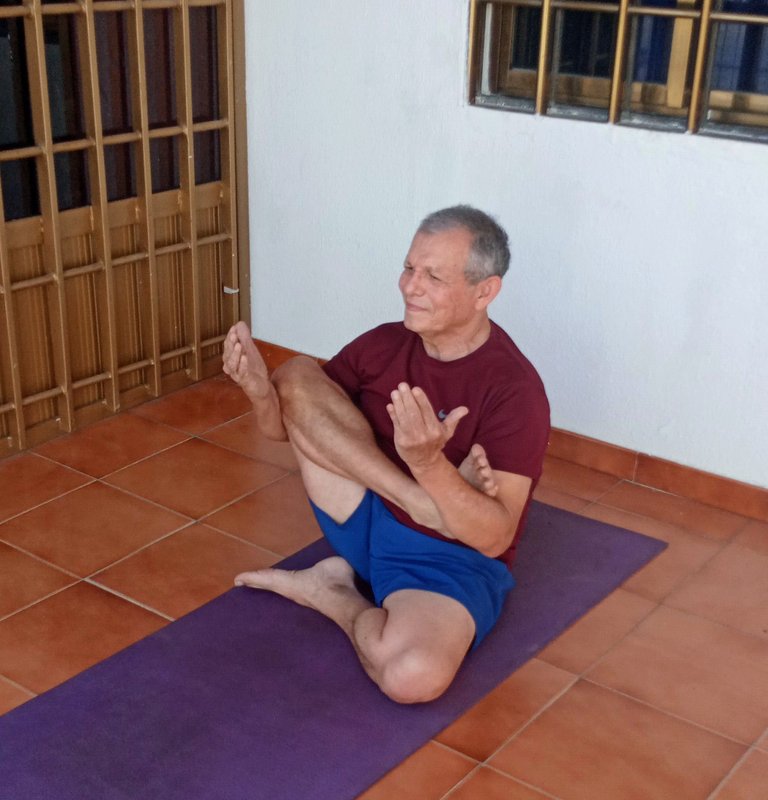
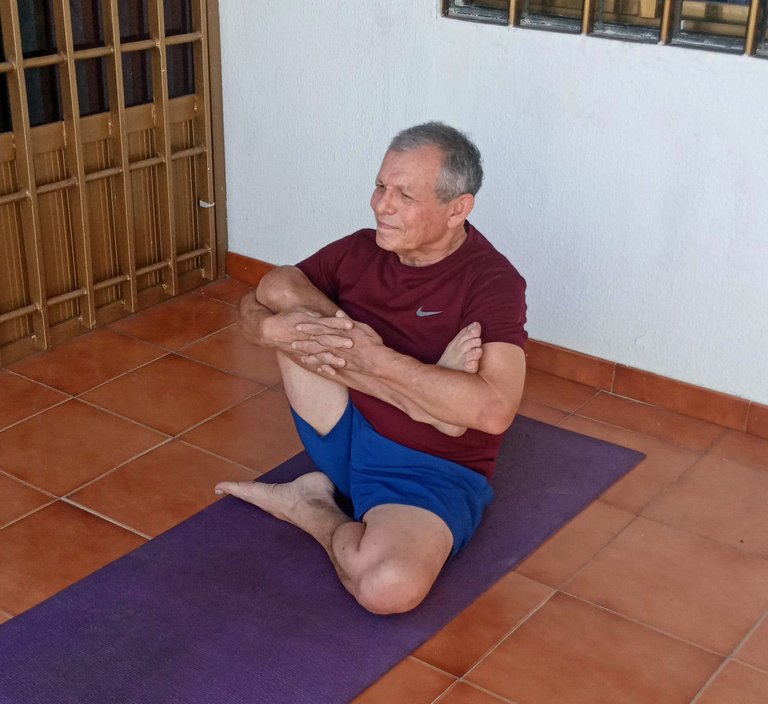
Keeping the back straight, leaving the left leg flexed, resting on the mat, we gently proceed to raise and flex the right leg, placing the foot on that side on the crook of the right elbow and the knee on the other crook of the left elbow, leaving the forearms directed upwards, while we bring the leg to the chest, then we form Hindolasana or the baby's cradle, managing to embrace the right leg, that is, the one that is raised, by interlacing the fingers of the hands, for this reason they are called the baby's cradle, we can even massage the abdomen and generate body strength, turning the torso gently, as if it were a cradle, in terms of posture lasting 30 seconds, to exercise or in movement, three minutes, balanced and in body resistance , inspiring, holding and expelling air. Successes.
Conformamos la variante de Hindolasana o la cuna del bebé, de la siguiente manera, ubicados en la postura anterior, es decir la cuna del bebé, separamos los dedos de las manos, con la finalidad de tomar con ellas, la rodilla y el pie de la pierna derecha, que se encuentra doblada, la cual llevamos lejos del pecho, durando 30 segundos en la mencionada variante, equilibrados y en resistencia corporal, inspiramos, aguantamos y expulsamos aire. Éxitos.
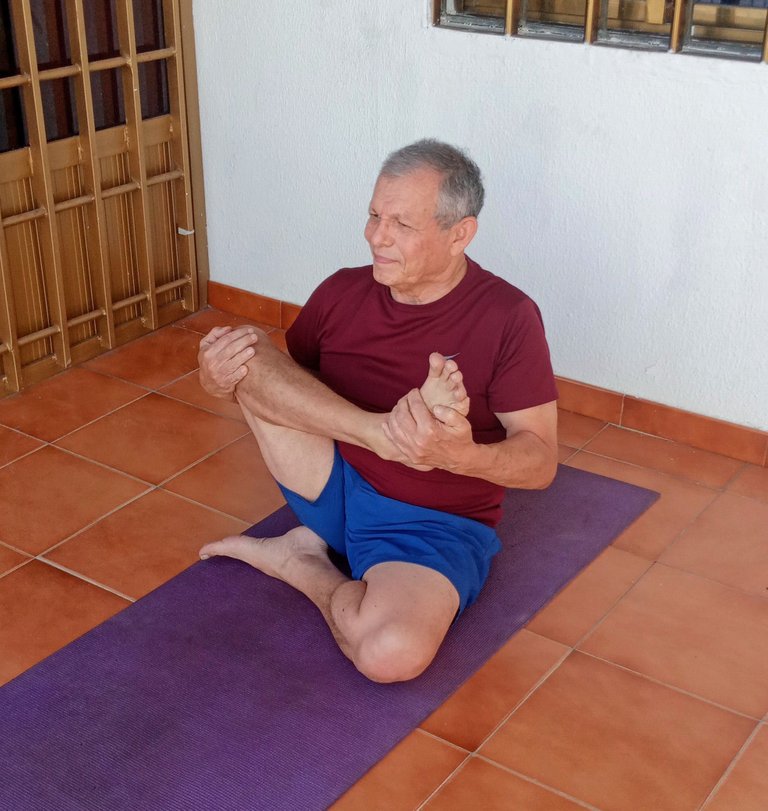
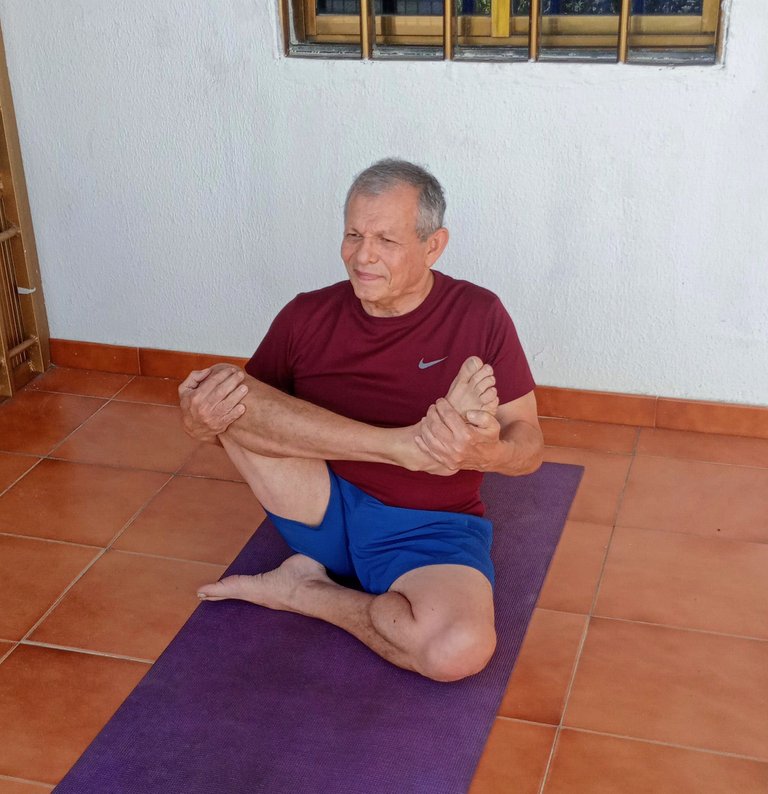
We form the variant of Hindolasana or the baby's cradle, as follows, located in the previous position, that is, the baby's cradle, we separate the fingers of the hands, in order to take with them, the knee and the foot of the right leg, which is bent, which we carry away from the chest, lasting 30 seconds in the mentioned variant, balanced and in body resistance, we inspire, hold and expel air. Successes.
Repetimos la variante de Hindolasana o la cuna del bebé, de la siguiente manera, ubicados en la postura anterior, es decir la cuna del bebé, separamos los dedos de las manos, con la finalidad de tomar con ellas, en esta ocasión la rodilla y el pie de la pierna izquierda, que ahora se encuentra doblada, la cual llevamos lejos del pecho, durando 30 segundos en la mencionada variante, equilibrados y en resistencia corporal, inspiramos, aguantamos y expulsamos aire. Éxitos.
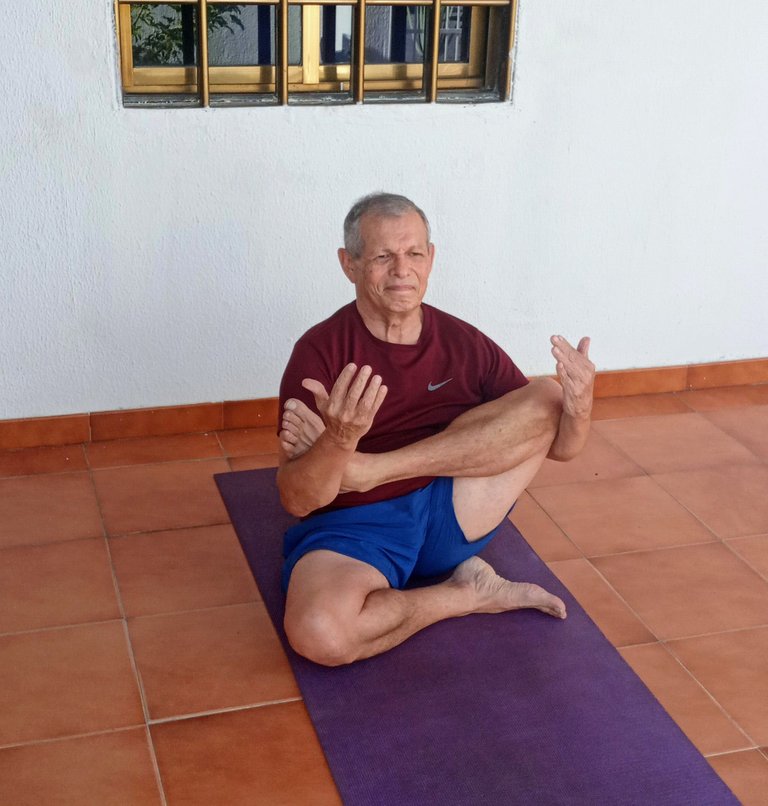

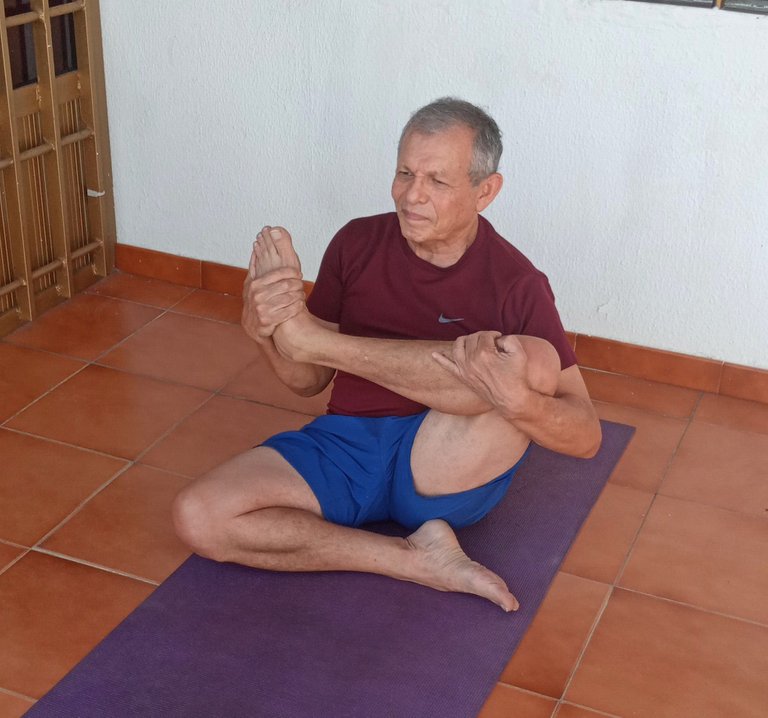
We repeat the variant of Hindolasana or the baby's cradle, as follows, located in the previous position, that is, the baby's cradle, we separate the fingers of the hands, in order to take with them, on this occasion the knee and the foot of the left leg, which is now bent, which we carry away from the chest, lasting 30 seconds in the aforementioned variant, balanced and in body resistance, we inspire, hold and expel air. Successes.
Beneficios de la postura Hindolasana o la cuna del bebé y su variante
- Son buenas posturas para contribuir con el estiramiento y fortalecimiento de los músculos isquiotibiales.
- Ofrecen un buen entrenamiento para las piernas.
- Permiten el proceso de relajación de las tensiones en la espalda baja y las caderas.
- Ayudan a masajear los órganos internos del abdomen, tales como; el estómago, el intestino delgado y el intestino grueso, el hígado, el bazo, la vesícula biliar, el páncreas, el útero, las trompas de falopio, los ovarios, los riñones, los uréteres, la vejiga y una gran cantidad de vasos sanguíneos.
- Son recomendadas para mejorar la postura.
- Las desarrolladas asanas, son excelentes para calmar la mente y aliviar la ansiedad
Benefits of Hindolasana or Baby's Cradle Pose and its variation
- They are good postures to contribute to the stretching of the hamstring muscles.
- They offer a good workout for the legs.
- They allow the relaxation process of tensions in the lower back and hips.
- They help to massage the internal organs of the abdomen, such as; the stomach, small and large intestines, liver, spleen, gallbladder, pancreas, uterus, fallopian tubes, ovaries, kidneys, ureters, bladder, and a large number of blood vessels.
- They are recommended to improve posture.
- The developed asanas are excellent for calming the mind and relieving anxiety.
Las posturas Hindolasana o la cuna del bebé y su variante, las cuales se desarrollan, en atención a los procedimientos descritos en la presente publicación, son muy recomendadas, por sus beneficios para el estiramiento y fortalecimiento de los músculos isquiotibiales y el proceso de relajación de las tensiones en la espalda baja y las caderas, así como también por su buena acción de masajear los órganos internos del abdomen. Otra de las bondades que presentan dichas asanas, lo representa el hecho de que mejoran la postura y su efectividad para calmar la mente y aliviar la ansiedad, en tal sentido, las mencionadas asanas, debemos tenerlas presentes como de rutina, en nuestras frecuentes prácticas de yoga, lo cual sería una buena ocasión para entrenar las piernas y su repercusión favorable para todo el cuerpo. Amigos, al saludarles cordialmente y agradecerles su receptividad y contínuas visitas, me suscribo a ustedes, con mucho afecto. Omar Gustavo Rojas Ortiz desde la ciudad de Cumaná capital del estado Sucre-Venezuela.
The Hindolasana postures or the baby's cradle and its variant, which are developed in response to the procedures described in this publication, are highly recommended due to their benefits for stretching and strengthening the hamstring muscles and the relaxation process of the hamstrings. tensions in the lower back and hips, as well as for its good action of massaging the internal organs of the abdomen. Another of the benefits that these asanas present is represented by the fact that they improve posture and their effectiveness in calming the mind and relieving anxiety. In this sense, the aforementioned asanas must be kept in mind as a routine in our frequent yoga practices. yoga, which would be a good opportunity to train the legs and their favorable impact on the whole body. Friends, greeting you cordially and thanking you for your receptivity and continuous visits, I subscribe to you, with much affection. Omar Gustavo Rojas Ortiz from the city of Cumaná capital of the state of Sucre-Venezuela.
Las imágenes fueron tomadas por Nancy de Rojas con mi celular Samsung Galaxy A10s y la publicación es de mi autoría.
The images were taken by Nancy de Rojas with my Samsung Galaxy A10s cell phone and the publication is my own.
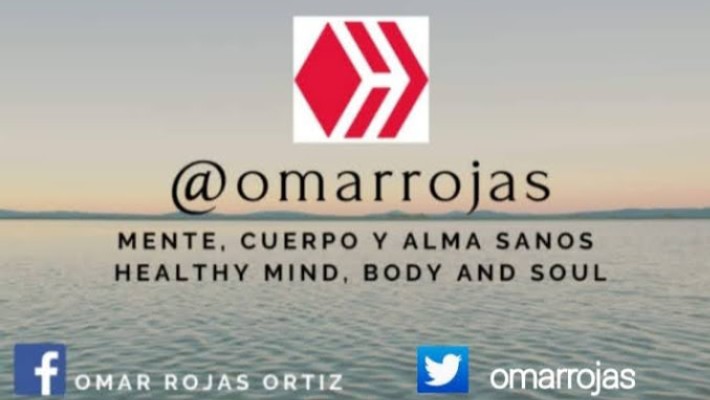
https://twitter.com/Omarroj52318483/status/1552685637295292416
The rewards earned on this comment will go directly to the people sharing the post on Twitter as long as they are registered with @poshtoken. Sign up at https://hiveposh.com.
Feliz tarde señor Omar, este es uno de los ejercicios excelentes para mejorar la postura , coordinación , aumentar la masa muscular en los glúteos, además, tonifica los abdominales, es una rutina muy completa.
Gracias estimado amigo @virgilio07 cierto, por cuanto al estirar y fortalecer los isquiotibiales, las piernas contribuyen a que los músculos abdominales y de la espalda tengan un efectivo soporte y la movilidad necesaria, no solo para los quehaceres cotidianos, sino que también es esencial para el deportes, yoga y la educación física. Gracias por comentar, éxitos.
Saludos mi estimado amigo. Que buena rutina la que hoy nos ofrece. En ocasiones he sentido estirones justo en esa zona, sobre todo cuando extiendo los dedos de los pies hacia abajo. Es una especie de calambre. Existe algún ejercicio para aliviar esas molestias?
Excelente Maestro Omar, simpre atento a los post que usted nos comparte. Saludos ✌️
Gracias estimado amigo @pedroerami sus palabras elogian mi trabajo y calman mi mente. Le deseo muchos éxitos, en sus publicaciones.